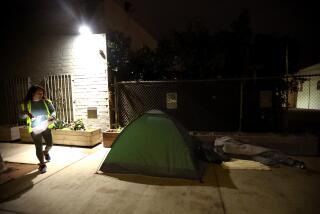Helping the Homeless
- Share via
From a distance the festive yellow and white awnings gave the appearance of an afternoon block party. In fact, the striped awnings provide shelter for about 600 homeless people in a dusty, fenced-off downtown encampment in Los Angeles. There was no party here. The television news camera focused on the listless eyes of a pregnant mother holding her young child’s hand and, behind her, the street-worn face of an old man. These three, along with more than 300 others, waited in line to see one of the doctors who had set up shop under the tents one weekend last month.
Dr. David Stein was from Florida. Touched by news stories of this sad community of homeless, he told the television reporter that he simply came to help. It is not unusual for doctors to spend their weekends helping the impoverished. For years Los Angeles physicians have provided medical care for thousands of Mexico’s poor. But this tented city was not in Mexico, nor was it in Ethiopia, India or Bangladesh. This was Los Angeles.
At first blush, one was struck with a feeling of impotence. Why is Los Angeles, a city with one of the highest per-capita incomes in the nation, unable to care for its homeless population without outside help?
Homelessness has increased dramatically in Los Angeles. Out-of-state immigrants continue to come without jobs and with little money. Unrealistically, they hope for a new start in a city of sunshine and ocean breezes--only to find expensive housing, confusing transportation and no paycheck. Others are mentally ill and need care. But mental-health resources have been limited by budget cuts. Still others, some estimate about 60%, have given in to a life of drug or alcohol abuse.
The needs of these people are as varied as their numbers. Local officials are attempting to grapple with the overwhelming problem. In a joint agreement between city and county governments, the city has agreed to postpone the closure of the downtown homeless campground until next month, and county health care and social services within the camp will be expanded--a temporary solution at best. And last week Mayor Tom Bradley announced the purchase of 102 mobile homes to be used as temporary shelters for the campground homeless. Although a good step, government resources are insufficient to reach the soaring number of homeless.
Stein’s visit was beneficial. Not only did it mobilize the local medical community and provide medical care for hundreds of the city’s indigent population, but it also focused attention on the need for public involvement. “We need volunteers,” Maxine Johnston, president of the Weingart Center, said. The Skid Row center provided the organizational assistance for Stein’s Los Angeles project. Although the center’s county-operated clinic treats about 300 patients a week, it does not have the manpower to provide the continuous on-site medical service necessary to care for the city’s fluid homeless population. The center needs, as well as medical personnel, volunteers with administrative expertise.
On-site medical treatment should continue. The homeless and their needs are a viable and visible part of Los Angeles. But local governments, wracked by tax-slashing budget reductions, have not met these needs. Remembering the success of the 1984 Olympic Games volunteer program, Johnston is convinced that a well-organized volunteer corps can help solve the problem of the homeless. We believe that she is right.
More to Read
Sign up for Essential California
The most important California stories and recommendations in your inbox every morning.
You may occasionally receive promotional content from the Los Angeles Times.













